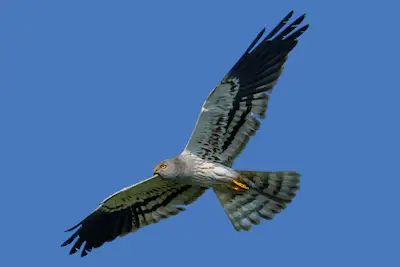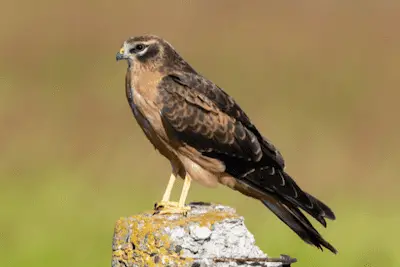Montagu’s Harrier
(Circus pygargus)
The Montagu’s Harrier is an elegant medium sized raptor that hunts with great agility over open country.

As a bird of open grasslands and steppes, the Montagu’s Harrier has become increasingly rare in the intensely cultivated farmlands of Europe.
This is a fate that it shares with many other birds of the open spaces, many of which don’t do well in industrial agricultural landscapes.
Because of this trend, sustained efforts must be made to protect these valuable habitats and species.
A very encouraging development in recent years is that the Montagues Harrier has been increasing in some areas due to strict protection, which provides hope for the future of this beautiful raptor species.
Montagu’s Harrier facts
The Montagu’s Harrier is one of the most agile and elegant raptor species in Europe, and is fast enough to catch birds on the wing.
Montagu’s Harrier Size
The Montagu’s Harrier is a medium sized harrier species found in Europe. While its wingspan approaches that of a Common Buzzard, the overall proportions of this raptor are much more slender and elegant.
- Montagu’s Harrier wingspan: 105-130 cm
- Length: 42-47 cm
- Weight: 320-450 g (females), 230-305 g (males)
The Montagu’s Harrier is also considerably lighter than the European Hen Harrier, even though the two harrier species share a similar wingspan.
Appearance
The Montagu’s Harrier is a medium sized harrier species in Europe. While its wingspan approaches that of a Common Buzzard, its overall build and proportions are much more slender and elegant.

Sexual dimorphism
Similar to most species of raptors in Europe, female Montagu Harriers are significantly larger than males, to the extent that they don’t overlap in size.
In addition to this, there is also a difference in coloration between the genders. Females are predominantly brown, while males are light to dark grey with black wingtips and black patches along their wings.
Lifespan
A maximum age of 16 years has been recorded in the wild.
Scientific name and taxonomy
The scientific name of the Montagu’s Harrier is Circus pygargus. No subspecies are known, but it is known to hybridize with the Pallid Harrier (Circus macrourus), which is its closest relative in Europe.
Montagues Harrier distribution
The Montagu’s Harrier breeds in most European countries, but is not very common in most of them. It avoids the northernmost regions of Europe, and is only found in the southernmost part of Scandinavia. Outside of Europe, the range of this bird of prey extends eastwards to Siberia.
Montagus Harrier habitat
Like all Harrier species in Europe, the Montagu’s Harrier requires open landscapes to hunt, and is most often found in grasslands, steppes, marshes, and in some cases cultivated farmland.
Before agriculture became more intensive, this raptor was actually common on extensively cultivated farmland.
Montagu’s Harrier population size
The European population of the Montagus Harrier is estimated to be between 35,000 and 65,000 pairs. The largest number of these birds is found in the European part of Russia, which has up to 35,000 pairs, followed by Spain (up to 10,000 pairs) and Belarus (up to 5,000 pairs).
Montagu’s Harrier behavior
Similar to most harrier species, the Montagu Harrier is most often observed flying slowly over open country at a low altitude, while scanning the ground below for prey in the open. Swoops down in a flash when it encounters rodents outside of their burrows.
Feeding and diet
The most important food source of the Montagu’s Harrier are small rodents, with voles in position one, followed by small birds, lizards, and insects. Since vole populations fluctuate heavily from year to year, Montagu’s Harrier switch to other types of prey in years with few voles.
Similar to a falcon, the Montagu’s Harrier is capable of taking small birds in the air, which is probably attributable to its very light build, making it more agile than larger raptors.
Breeding
Just like all European harrier species, the Montagus Harrier builds its nest on the ground in open country with dense vegetation. Common choices of nesting grounds are reed beds and grassfields. In recent years, Montagu’s Harrier have increasingly started nesting in wheat fields and other cultivated crops.
The female lays 3-5 eggs, which are incubated for up to 31 days. After hatching, the young harriers stay in the nest for up to 33 days, and continue to be fed by their parents even after they leave the nest.
Montagu’s Harrier Migration
The Montagu’s Harrier is a strict migratory bird that travels over long distances every year. It crosses the equator to spend the winter in Africa south of the Sahara.
Montagu’s Harriers prefer to cross the Mediterranean at its narrowest straits, in order to avoid flying over open water for long periods. Because of this, their main migration routes run via France and Spain, or via Italy and Sardinia. Eastern populations fly via Greece and Crete.
Montagu’s Harrier conservation status
The population of the Montagu’s Harrier in Europe has declined heavily due to changes in agricultural practices during the past century. However, this population decline seems to have been halted in recent years, and the overall European population of the Montagu’s Harrier is currently stable.
As a result of stable population numbers, the conservation status of the Montagu’s Harrier is currently classified as of “Least Concern” by BirdLife International.
Part of this trend may be due to the fact that Montagu’s Harriers have started adapting to using cultivated farmland as their habitat, and as a result of this, populations in some areas have even been on the rise.
Threats
The biggest threat to the Montagu’s Harrier is destruction of its habitat. It shares this vulnerability with many other bird species that live in open landscapes that have suffered intensely due to the intensification of agriculture throughout Europe.
Protecting or recreating Montagu’s Harrier habitat would thus benefit many other species as well. Apart from habitat destruction, the biggest threat to these birds is direct persecution due to illegal shooting during migration, which must be stopped.
Additional resources:
- Western Marsh Harrier size
- European Sparrowhawk distribution and habitat
- Northern Goshawk feeding and diet
